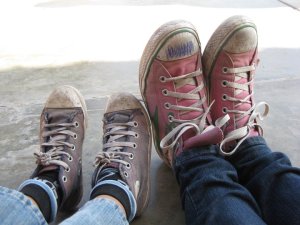A look at the everyday struggles of a student.

A look at the everyday struggles of a student.
People with mental health often face stigmatization from others. Here is a video highlighting one person’s experience with mental illness and how she feels about what others think about her because of it.
An interview with Joan about her experiences with mental health illness and how she feels she is perceived.
Weight is a pretty big issue in North America. You hear about the “obesity epidemic” in the news, and in a lot of ways it should be a concern. There are a number of health-related issues to obesity, including diabetes, heart problems, and general well-being issues.
If you were to look around the world, most societies favour physically fit individuals with low body-fat seen as a beauty ideal. However, this hasn’t always been the case. Looking back to Renaissance Europe and even Classical era Greece and Rome, the beautiful women were the round, voluptuous ones. In one sense, their weight signified wealth because it meant they could afford to feed themselves.
In one part of the world this idea that extra weight is beautiful remains. The Azawagh Arabs of Niger in Africa still practice an ancient custom of fattening. At a young age, girls are forced to eat enormous quantities of milk and porridge until stretchmarks cover most of their body. Big, round, fleshy bodies are the ideal that signifies beauty.

Toronto graffiti showing the extremes people will go to for a ‘beautiful’ body. Photo credit: Samantha Daniels
In a strange sense, this is similar to our society. In both cases, the natural body needs to be ‘socialized’ until it is an acceptable specimen in terms of societal norms.
The Azawagh Arab’s fattening through immobility and gorging is the same as our culture’s slimming through exercise regimes and fad diets. And you may think one is inherently better than the other. Fatness can lead to health problems, but so can skinniness. Either way, it’s a refusal of what comes naturally in preference of an ‘idealized’ form.
So be the change. Accept your body for whatever you were given naturally. The idea that desirability depends on how big or small you are is as ridiculous as it depending on your eye colour.

A comparison of the best an average Peruvian girl has to wear (left) and what I brought to wear as a middle-class Canadian (right – me). Image: Samantha Daniels
I went to Peru in the summer of 2011 with a group of students from my school. We went to help a school rebuild one of their school houses, repaint, and to teach to students English.
I remember the first morning we were going to the school, we sat on the bus for a good hour, slowly winding our way out of beautiful, pristine Lima, with its manicured lawns and spotless streets, towards the ever increasing poverty of Callao. Paved roads turned to dirt, litter started to collect, and the smell of burning garbage grew more and more intense. I had never experienced true poverty, and there are no words to be able to fully describe it.
The school teaches students ranging from 4 to 16, and a lot of families could only afford to send one child. The students lucky enough to attend wore uniforms, but in the afternoons when they came back to play and do workshops with us, they’d wear their everyday clothes. Often the only outfit they owned, these clothes were dirty and passed down to them by an older sibling.
The stark difference between our worst clothes, meant to be destroyed by paint and whatever work we did, were beautiful and new compared to the clothes they had. One girl wore lululemon clothes the entire trip. Hundreds of dollars of expensive outfits were disposable to this girl, while these kids were lucky to own a second pair of pants.
It’s sad to think that people here get upset about clothes not fitting perfectly or not owning the newest fashion trend. People around the world can barely clothe themselves and we’re surrounded by closets full of them. Having a choice of what to wear each day is a luxury we take for granted.
This blog is a school project, and will be run by my assignment schedule. Please come back soon for upcoming posts!
In the meantime, leave me some ideas you have for posts!
Throughout history, one thing is consistently present: conflict.
As a seemingly universal experience of all humans, our world revolves around conflicting ideals and beliefs spurring from areas of uncertainty. The most obvious are the big trigger areas, such as wealth, politics, and religion, which are often topics to avoid when talking to anyone but those closest to you — and sometimes you still have to choose your words wisely.
Everyday we are exposed to conflict, not only on the individual level, but also within each group/society, as well as on the global scale:
Not only are you in daily conflict with yourself, your society, and the rest of the world, but each is in conflict with you and the others. A society may disagree with your life choices, a country may disagree with with another country’s policies, it seems everyone is in conflict with something.
Even science, the closest we have come to knowing the objective truth, is contested by many around the world. With an ever increasing supply of ideas and points of views from which to interpret an occurrence, it becomes more and more unlikely for everyone, let alone a couple people, to fully agree on what is true about the world.
With so many versions of the truth, my goal is to present as many of these conflicting ideals as possible to make space for understanding, and perhaps more tolerance. People’s opinions aren’t going to change overnight, so instead of trying to convince others to see as you see, we all might as well try to understand where they’re coming from. It may even change your mind about how you see the world.
From my individual perspective, going into university from a science-dominated background, I was used to the black-and-white answers that only science can provide. 1 + 1 always equals 2 in science. So, I started my first year in the health sciences, thanks to my high school love of chemistry and grandiose ideas of being a neurosurgeon.
By the end of my first year I realized it wasn’t for me, and that left me lost. For two years, I struggled to stay in a program for more than a semester, taking me through courses in English, Classics, religion, psychology, astrophysics… a little bit of everything. I was introduced to so many new ideas and perspectives of the world, all of them conflicting and muddling up my simple world of science.
These conflicting ideas gave me a lot to consider, and frankly, they confused me. It was hard to accept that the concept of only one right answer didn’t transfer beyond scientific understanding. I looked for the ‘right’ answers and came up with nothing.
So, in this world of many sides to the truth, I ask you to keep your mind open to new possibilities. You may not fully agree with what I’m presenting, but that’s not the point. Hell, I’m probably not going to agree with everything I’m writing. The point is to try to see something from a new perspective and perhaps learn to view your own world of truths in a different way. If you do, tell me what differences you see, and if not, tell me what you think is right.
This is an open learning experience for whoever wants to participate.